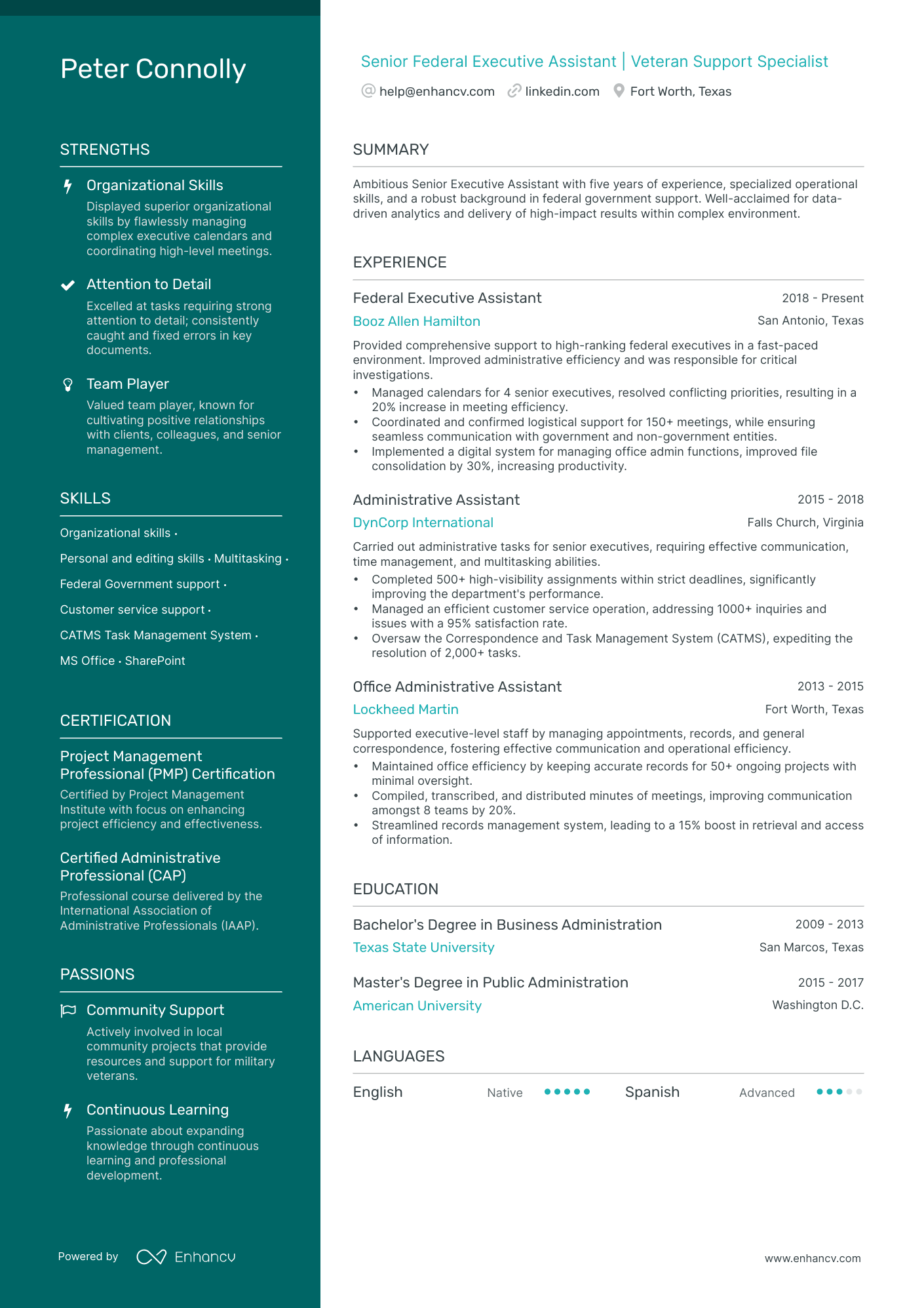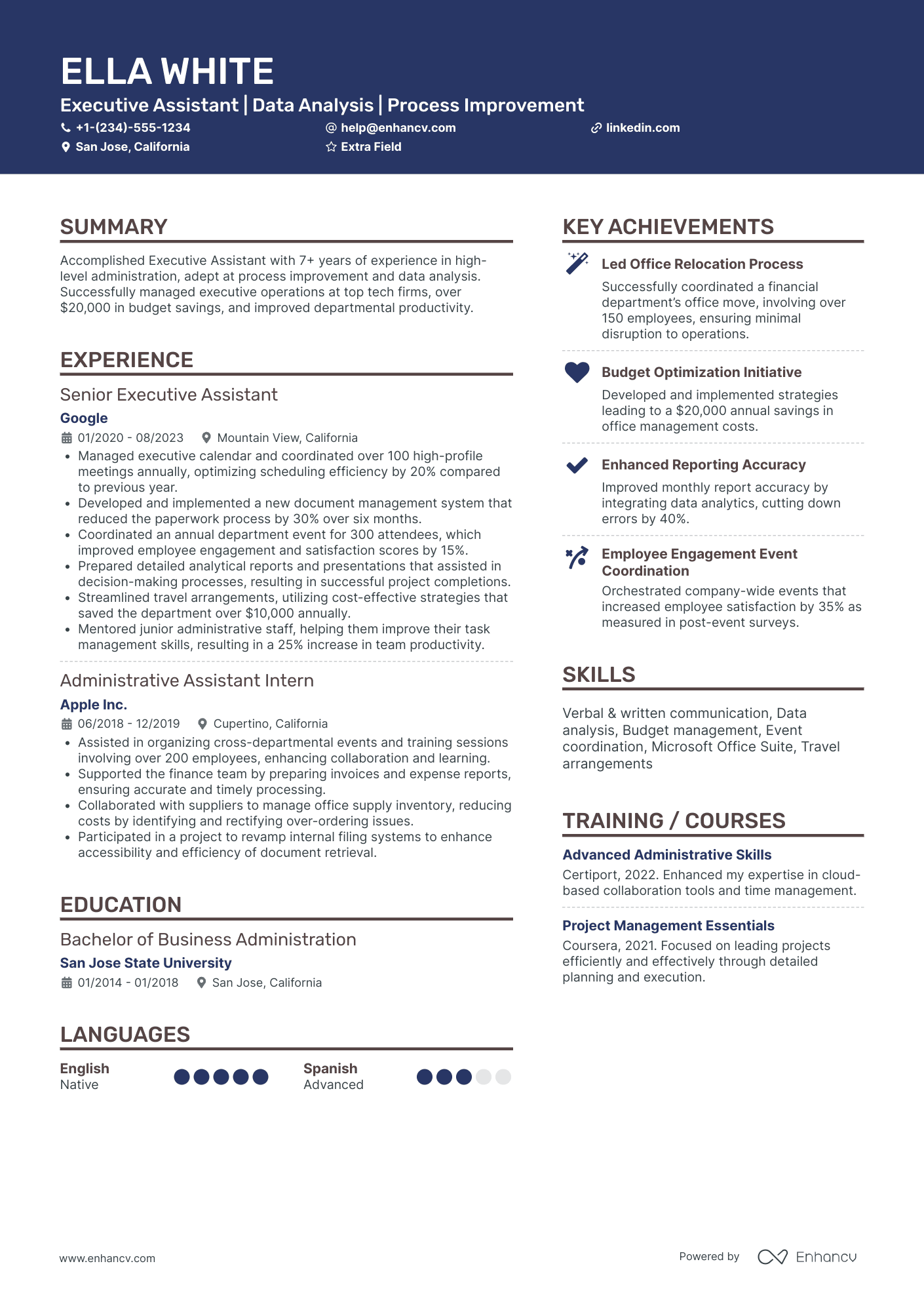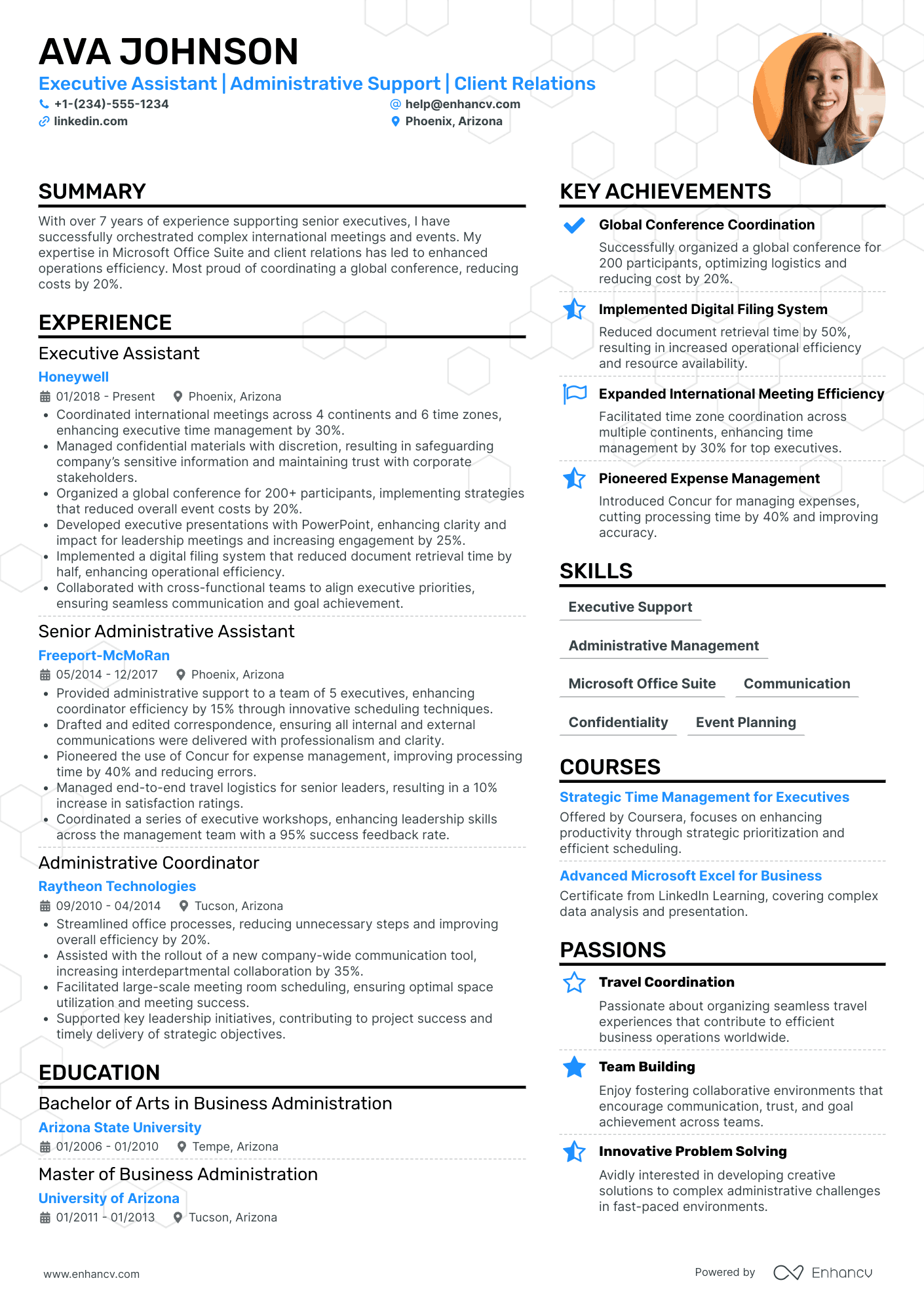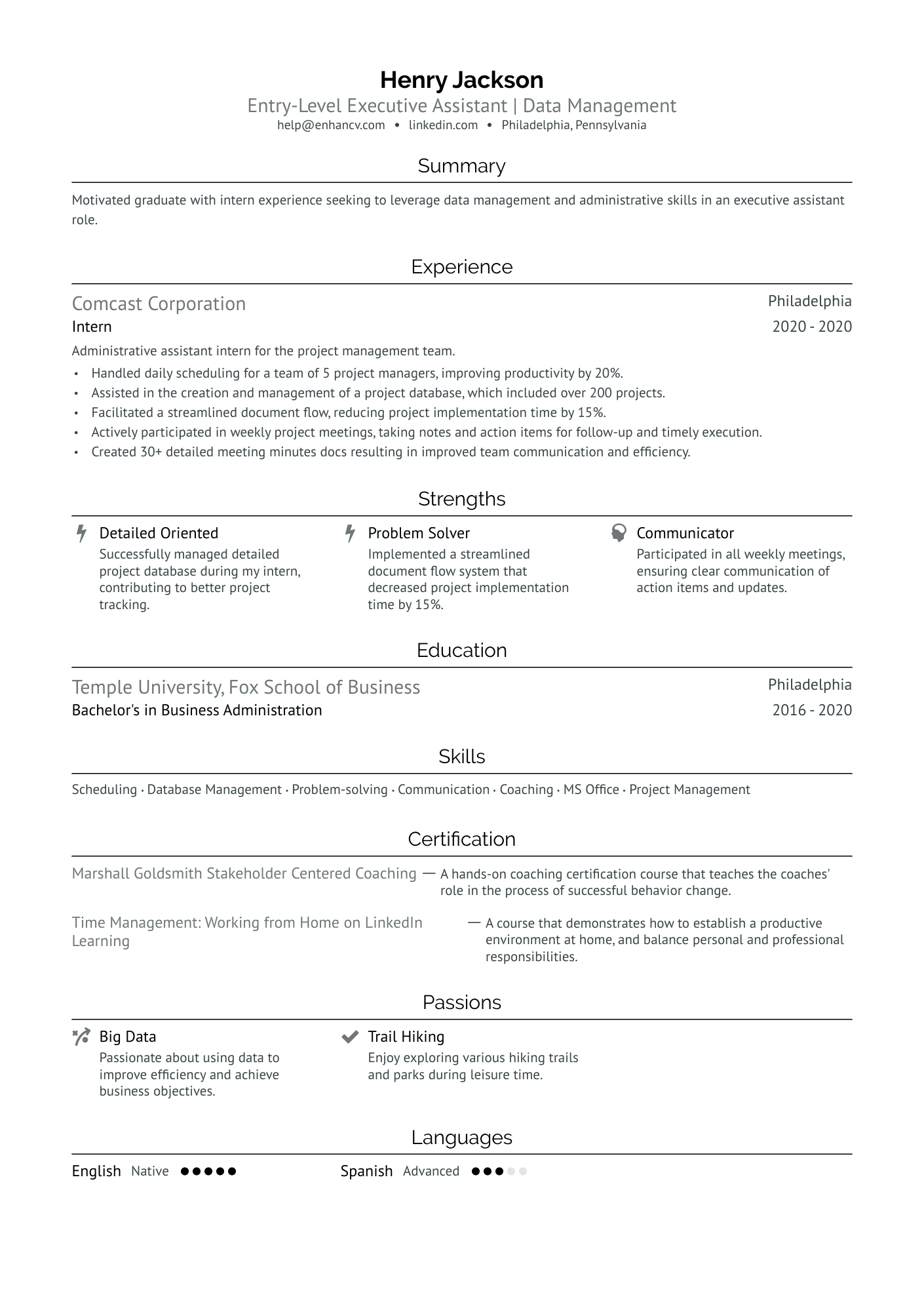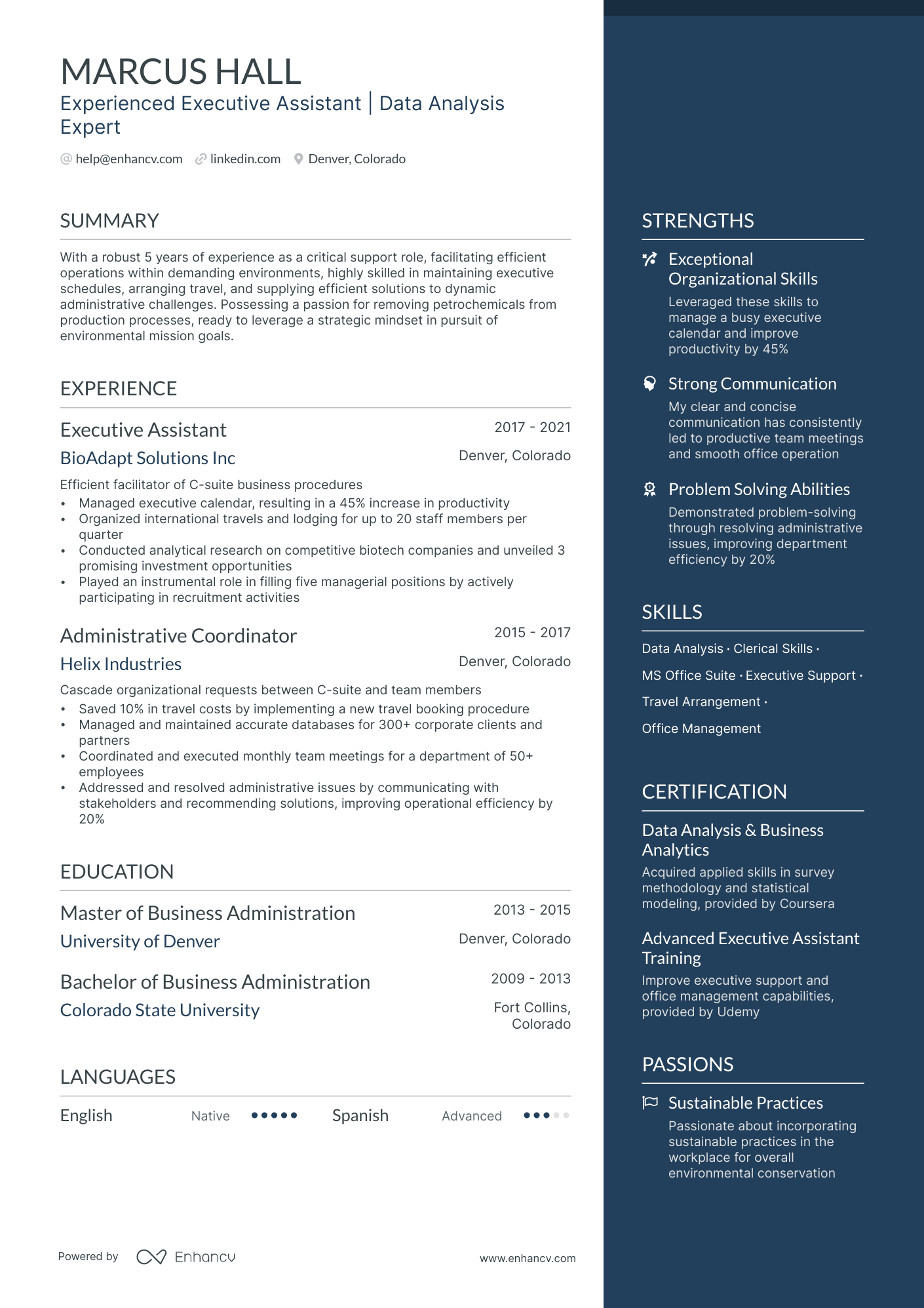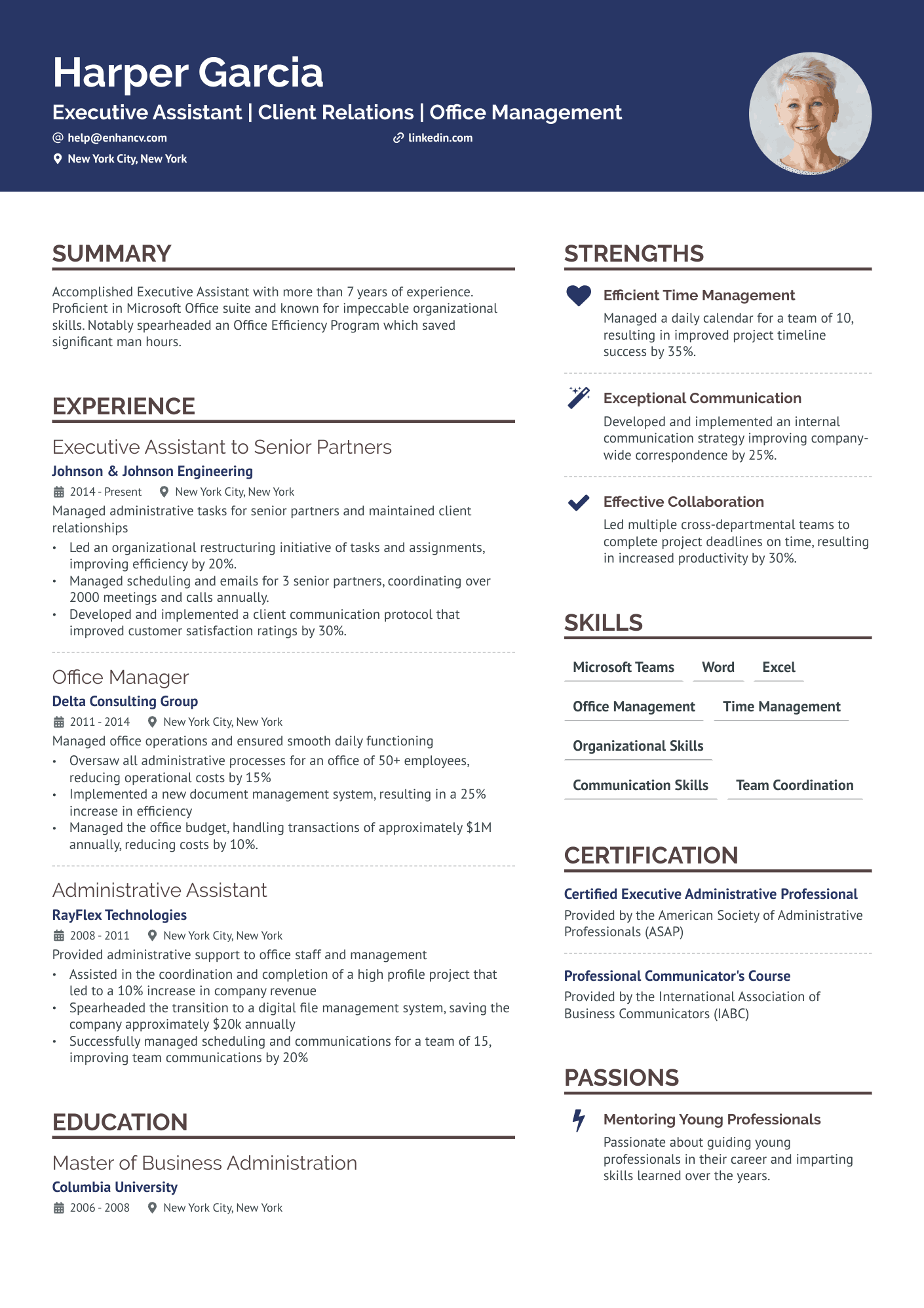In today's fast-paced business world, executive assistants play a pivotal role in ensuring the smooth operation of an organization. From managing complex schedules to handling sensitive communications, exec assistants are the backbone of executive efficiency. If you aim to land a job in this crucial role, a well-crafted executive assistant resume is your ticket to success.
Did you know that the demand for executive assistants is projected to grow significantly in the coming years? This surge is driven by the increasing complexity of executive roles and the need for skilled professionals to manage them. Additionally, executive assistants often enjoy a high level of job satisfaction due to the dynamic and impactful nature of their work.
However, navigating the job market as an executive assistant can present its own set of challenges. Crafting a resume that effectively showcases your unique skills and experiences is just the beginning. Many candidates find it difficult to articulate their diverse responsibilities and the critical role they play in executive management. Moreover, standing out in a competitive job market requires a strategic approach to highlighting your achievements and demonstrating your value to potential employers.
Behind every successful executive is an exceptional assistant who knows how to make things happen.
Cynthia S. Thompson, founder of The Thompson Group and executive assistant training expert
In this article, we'll guide you through the essentials of creating an outstanding resume for executive assistant positions. From tailoring your experience to emphasizing your soft skills, we'll provide tips and insights to see what exactly makes a good resume.
Let's dive in and start building a resume that will open doors to your next exciting career opportunity!
In this guide we’ll answer the following CEO executive assistant resume questions and more:
- What’s the best resume format and the top sections for an executive assistant’s resume?
- What are some common problems candidates face while applying for an executive assistant position?
- How can you write the most effective work experience entries and things to do if you don’t have any experience?
- What’s the best way to list your hard and soft skills?
- How should you present your education and certification successfully on a resume?
- Why do you need to create an amazing resume summary or objective?
- Do you need to include any additional sections on your resume?
Looking for a more specific executive assistant position? Have a look at some other related resume guides from Enhancv:
In recent years, the rise of virtual executive assistants has added another layer of complexity—and opportunity—to the job market. As a virtual executive assistant, you'll need to be particularly adaptable, leveraging technology to communicate effectively and manage tasks remotely. This role requires a high level of digital literacy, as well as the ability to stay organized and responsive without the traditional in-office environment.
Let’s begin by exploring the different resume formats that can best showcase your skills and experience.
How to format an executive assistant resume
When crafting your CEO assistant resume, it's essential to choose the right format that emphasizes your strengths and experiences effectively. There are several types of resumes but we’re only going to look at the most popular ones now. Here are the best ways to format your resume:
This format lists your work experience in reverse chronological order, starting with the most recent position. It’s best for candidates with a solid, continuous work history in executive support roles.
This format focuses on your skills and experiences rather than your chronological work history. It’s ideal for candidates with gaps in their employment or those switching careers to become an executive assistant.
This format combines elements of both reverse chronological and functional formats. It highlights both your skills and your chronological work history, making it suitable for candidates with a diverse skill set and a consistent work record.
Whether you’re a seasoned executive assistant with extensive experience managing complex schedules and high-level communications, or you're new to the field, focusing on substance over style is crucial. Choosing the right resume format can help you get noticed for your skills and accomplishments rather than just aesthetics.
Below are a few more factors to consider when deciding on your resume layout.
Resume design
- Template: If you want your resume to highlight your executive assistant experience alongside your key skills, consider using a double-column template. This allows you to present your work history and achievements in one column, and your technical skills and additional qualifications in the other, creating a visually engaging layout.
- Margins: Keep your resume margins between 0.5 and 1 inch. This ensures the document is clean and uncluttered, much like a well-organized executive's calendar.
- Colors: Neutral tones like greys or blues can add a touch of professionalism while keeping the look elegant. These colors help convey a sense of sophistication and clarity, ensuring your resume stands out without overshadowing your qualifications.
- Fonts: Choose clear, ATS-friendly fonts, sized between 10 and 12 points. Fonts such as Arial, Calibri, and Times New Roman perform well in the eyes of recruiters.
- Resume length: Keep your resume to one page—two at most if you have extensive experience. If you need some tips on how to shorten your resume, we got you covered.
- Lines: Including lines on your resume can help organize sections and improve readability, but it's important to use them sparingly and ensure they don't interfere with ATS compatibility.
Resume header
- Contact information: Begin with your name, job title, and address on your resume. Make sure your resume header is professional and includes a reliable email.
- Links: Include a link to your LinkedIn profile and/or professional portfolio. Hiring managers often look here to assess your professional experience and network. Ensure your LinkedIn profile is updated and reflects your resume.
- Resume photo: Generally, it’s best to omit photos to maintain focus on your qualifications and avoid potential biases.
- Resume headline: A strong resume headline can immediately convey your core strengths and value to potential employers.
Different regions expect different formats – Canadian resumes, for example, may look unique.
PRO TIP
For an executive assistant, a headline should highlight your organizational skills, experience supporting executives, or proficiency in managing complex schedules.
"Highly Organized executive assistant with 10+ Years of Experience in Managing Executive Schedules and Streamlining Office Operations."
This headline gives a clear and concise snapshot of your qualifications, making it easier for recruiters to see your value at a glance.
File formatting and naming
- File format: Always save your resume as a PDF to preserve the layout and formatting across different devices.
- Naming convention: Name your file professionally; for example, ‘FirstName_LastName_Executive_Assistant_Resume.pdf’.
- Applicant tracking system (ATS) compatibility: Avoid confusing and complex formatting. This maintains readability and ensures your resume easily passes through ATS, which is commonly used to help filter candidates.
More on ATS
The most important thing to remember about ATS systems when creating your resume is to ensure it’s ATS-friendly by using simple, standard formatting and it’s always a good idea to include relevant keywords. This means avoiding complex layouts, images, and graphics, and using clear headings, bullet points, and fonts. Additionally, tailor your resume with keywords and phrases from the job description to improve your chances in general.
Just remember there isn’t anything that results in automatic rejection or any impenetrable barriers when it comes to ATS. At the end of the day, it’s the recruiter who decides to call you in for an interview or not.
Wondering how your current resume would hold up? Run it through our AI-powered resume checker and see!
Is your resume good enough?
Drop your resume here or choose a file. PDF & DOCX only. Max 2MB file size.
Here are the main sections your resume will need to have any success:
The top sections on an executive assistant resume
- Professional summary: Include this to offer a brief overview of your capabilities and experiences that align with the executive assistant role.
- Work experience: Provide your past job history here, emphasizing your experiences as an executive assistant to showcase your relevant background.
- Technical skills and competencies: This section will highlight your administrative skills like scheduling and coordination abilities which are essential for the executive assistant job.
- Education and certifications: Recruiters often look at this section to verify your formal education and any additional certifications you may possess like administrative or office management training.
- References: Even though it's sometimes an optional part, it's good to provide references to demonstrate the credibility of your work history and skills as an executive assistant.
Within those sections, it’s vital to do your utmost to impress those recruiters. Below is an important list for you to reference as you write your resume. We compiled the top 5 elements that HR managers consistently seek out in their candidates. Take note!
What recruiters want to see on your resume
- Proven experience: Recruiters prefer to see evidence of you having previously held executive assistant roles to demonstrate your understanding of the job expectations.
- Organizational skills: As an executive assistant, your ability to manage several tasks and prioritize effectively is critical, showcasing your organizational prowess can put you in good stead with recruiters.
- Communication skills: Recruiters put a high value on this since your role as an executive assistant will require communicating clearly and effectively with various individuals.
- Technical proficiency: Demonstrating your knowledge and ability in using office management software, email platforms, and other productivity tools is essential as it’s integral to daily operations on the job.
- Confidentiality: Given the sensitive nature of the work, recruiters prioritize individuals who exhibit a strict adherence to and understanding of confidentiality guidelines and practices.
Writing a resume wouldn’t be complete without facing some difficulties.
Common problems for executive assistants
Here are some of the top issues that executive assistants may come across while writing a resume or applying for a job, along with practical solutions for each:
Problem: Showcasing advanced technical skills on an EA resume can be challenging. With numerous tools like Asana and Google Suite being essential, it's tough to highlight proficiency without overcrowding the resume.
- Solution: Create a dedicated "Technical Skills" section where you list relevant software and tools. Use bullet points to keep it concise and consider including a proficiency level for each tool (e.g., "Asana – Advanced").
Problem: Proving your worth with quantifiable achievements can be challenging, as an executive assistant's contributions aren't always easily measured. Presenting tangible evidence of your efficiency and effectiveness on your resume is crucial.
- Solution: Focus on specific outcomes and improvements. For example, "Implemented a new scheduling system that reduced meeting conflicts by 30%," or "Streamlined office procedures, resulting in a 20% increase in overall efficiency."
Problem: The competition is often high for executive assistant positions, so it’s important to make your resume stick out, but getting this right without seeming over the top is often tricky.
- Solution: Use a professional resume template with subtle enhancements. Incorporate a clean layout with clear headings, bullet points, and a splash of color to highlight sections, ensuring it remains professional yet distinctive.
Problem: Balancing soft skills with professional experiences on a C-Level executive assistant resume is challenging. These roles require a blend of interpersonal skills and administrative expertise, making it difficult to craft a well-rounded and compelling resume.
- Solution: Incorporate soft skills into job descriptions, such as "Effectively coordinated with team members and executives for seamless operations" or "Solved problems efficiently in managing executive schedules and priorities."
Problem: Finally, confidentiality is a crucial part of the executive assistant role. However, demonstrating your respect and understanding of this on a resume, without violating any previous confidentialities, can be a complex issue to navigate.
- Solution: Use general statements like, "Maintained strict confidentiality of sensitive information and executive communications," to convey your experience without revealing specifics.
Now with that covered, we can move on and explore the different sections of your resume in more detail.
An executive assistant is like a duck: calm on the surface, but always paddling like the devil underneath.
Unknown
How to write your executive assistant resume experience
Listing work experience on an executive assistant resume is crucial because it demonstrates your practical skills, reliability, and ability to handle the demands of the role. It shows potential employers your career progression, the scope of your responsibilities, and your achievements in previous positions. This helps them assess how well you can perform in the executive assistant role and contribute to their organization.
Of course, these need to be listed in reverse chronological order starting with your most recent job first and then working backward.
PRO TIP
If you’re wondering how far back you should go on your resume—the general rule is to include 10 to 15 years of work experience, focusing on relevance. Consider dividing your experience into "relevant" and "recent" and then tailoring them to highlight experiences pertinent to the job you're applying for.
How to write a work experience entry on a CEO executive assistant resume
When writing a work experience entry on an EA resume, include the following elements:
Job title and company name: Clearly state your job title and the name of the company. This provides context about the level and type of roles you've held.
Location and dates of employment: Include the city and state, along with the duration of your employment. This gives a timeline of your experience.
Key responsibilities: List your primary duties and responsibilities using bullet points. Focus on tasks that highlight your administrative, organizational, and technical skills.
Examples:
- Managed complex calendars and scheduling for senior executives.
- Coordinated travel arrangements, including international travel and itineraries.
- Prepared and edited correspondence, reports, and presentations.
Achievements: Include specific, quantifiable achievements to demonstrate your impact and effectiveness in the role.
Examples:
- Implemented a new filing system that increased document retrieval efficiency by 40%.
- Organized company-wide events, leading to a 20% improvement in employee engagement.
Tips for writing work experience entries
- Use action verbs: Start each bullet point with a strong action verb to make your responsibilities and achievements more dynamic and engaging. Examples include "managed," "coordinated," "implemented," and "improved."
- Be specific and quantify: Whenever possible, use numbers to quantify your achievements to provide concrete evidence of your impact. This can include percentages, time saved, or number of events coordinated.
By including these elements and following these tips, you can create compelling work experience entries that effectively showcase your skills and accomplishments as an executive assistant.
Tailoring your resume
Just as executive assistants meticulously organize schedules to ensure optimal productivity, targeting your resume to a job description ensures that it effectively highlights the skills and experiences most relevant to the specific job. This can also help your resume get past Applicant Tracking Systems that many companies use.
Another extremely useful method is to do some research on the company you’re applying to. Finding out what they’re passionate about and gaining insight into their company culture could give you a ton of effective information.
To illustrate this, we’ve provided an actual example of a job posting below for an executive assistant. Let’s craft our experience entries based on that, and you can see how effective a targeted resume can be.
Job Title: Executive Assistant
Job Description: Do you love to immerse yourself in a team and gain deep departmental knowledge that enables you to help everyone that comes your way? Do you have a passion for video games? If so, then the Executive Assistant position in Make Believe Games at The Mighty Gaming Company might be right for you!
This position supports the Vice President of Marketing and Vice President of Business Development and Licensing for Make Believe Games. You would be a key member of a dynamic, fast-paced team and would work with the most creative, resourceful people in the business.
We are searching for someone with support experience who also demonstrates curiosity and passion for games. If that's you, apply today!
Key Responsibilities and Duties:
- Thoughtfully manage complex calendars and protect the executives' time through strategic and proactive calendar management and vetting a variety of meeting requests.
- Handle Travel & Entertainment expenses for your team, book travel for your leader and/or team and build travel itineraries.
- Proactively resolve problems and pitch in to help.
- Coordinate onboarding/offboarding of team members.
- Process and track payments to vendors using SAP.
- Plan recognition and team events.
- Order supplies and equipment along with other office management duties like coordinating office space.
- Manage project tracking and follow-up.
- Prepare reports to be shared with leaders and stakeholders.
- Compose correspondence on behalf of the leader.
- Schedule and host Zoom meetings which could include presentation sharing.
- Attend meetings to take notes as well as follow up on action items.
- Partner and consult with your leader in high-level discussions.
- Prepare professional PowerPoint Decks.
- Research and report on specific topics as required.
- Manage your executive’s Inbox to include composing correspondence on behalf of the Executive, maintaining the utmost discretion with highly confidential correspondence and information.
- Work closely with the Executive on activities, projects, meetings, event planning, and office logistics.
Qualifications:
- Proven success partnering and interacting with all levels of Cast Members/Employees including Executive Leadership
- Strong proficiency with standard office tools such as Microsoft Outlook, Word, PowerPoint, Excel
- Generally tech-savvy and willing to learn new skills
- Professional and highly discreet while maintaining absolute confidentiality
- Effective communication skills, including diplomatic and professional handling of telephone and email communications
- Ability to be proactive, resourceful, flexible, and responsible
- Ability to take initiative and anticipate needs
- Extremely well organized and attentive to detail
- Good knowledge of games and the gaming industry
Experience:
- A minimum of 5+ years of experience supporting business executives in large organizations in an administrative role
- Prior experience supporting at the VP level (preferred)
- Experience working in a large publicly traded company (preferred)
Education:
- Required: High School Diploma
- Preferred: Bachelor's Degree
Location: Los Angeles, CA
Job Type: Full-time
Pay: $60,400.00 to $80,900.00 per year based on a 40-hour work week.
Have a specific job post you want to tailor your resume to? No problem! Just use our free AI-assisted resume scanner and get your ATS compatibility score instantly!
Now, let’s examine some work entries. This first example shows a noticeable absence of key elements.
- •Managed calendars for the executive team.
- •Organized travel arrangements.
- •Handled various administrative tasks.
- •Assisted in coordinating office events.
Here’s what’s missing in that example:
- Lacks specificity: The bullet points are too vague and don’t detail the scope or impact of the tasks performed.
- Misses key responsibilities: Important duties such as managing expenses, project tracking, and preparing reports are omitted, which are critical for the executive assistant role at The Mighty Gaming Company.
- No quantified achievements: The entry doesn’t provide any quantifiable achievements, such as efficiency improvements or cost savings, to demonstrate the impact of the candidate's work.
Now let’s remedy that entry so it becomes a more relevant, targeted, and descriptive example.
- •Efficiently managed complex calendars for the executive team, improving meeting scheduling efficiency by 20%.
- •Coordinated international and domestic travel arrangements, creating detailed itineraries that streamlined executive travel.
- •Implemented a new office supply tracking system, reducing costs by 15% through improved inventory management.
- •Organized and executed company-wide events, enhancing team collaboration and morale.
Let’s look at exactly what was improved:
- Specific and relevant details: The bullet points provide specific details about the tasks performed and their relevance to the executive assistant role.
- Industry alignment: The improved entry includes tasks that align with the job post’s focus on organizational and administrative skills, relevant even if the company isn’t in the gaming industry.
- Expanded responsibilities: The entry includes a range of responsibilities, from calendar management to event organization, showcasing a well-rounded skill set.
- Quantified achievements: The entry quantifies achievements, such as improving scheduling efficiency and reducing costs, demonstrating the candidate’s impact.
It would be a good idea for us to continue on the theme of quantifying, so let’s look at some great ways you can do just that on your next application.
How to quantify impact on your resume
Here are some tailored tips that any executive assistant could utilize to make their impact more noticeable and impressive.
- List the size of the budget you managed for executive office expenses, showing your financial management capabilities.
- Mention the number of high-stake meetings you coordinated and executed flawlessly, highlighting your meticulous planning skills.
- Indicate the response time for email correspondence under your management, offering insight into your promptness and professionalism.
- Provide details on the volume of documents processed or generated, which indicates your work efficiency.
- Note the number of executives or managers you provided support for, demonstrating your ability to multitask.
- Quantify any process improvements you initiated that resulted in time or cost savings, highlighting your solution-oriented mindset.
- State the number of countries you coordinated travel arrangements for, demonstrating flexibility and international business understanding.
- Specify the percentage decrease in executive scheduling conflicts under your management, indicating your organizational skills.
PRO TIP
Network strategically and leverage LinkedIn to connect with professionals in your desired industry. Attend industry events, join relevant groups, and actively engage with posts and discussions. Building a strong professional network can lead to valuable referrals and insights about job opportunities, significantly enhancing your chances of landing an executive assistant position.
How do I write an EA resume with no experience
Writing a resume for an executive assistant position without having any relevant past work experience might seem daunting, but don’t worry—you’ve got this!
Even without direct experience, you have valuable skills and attributes that can make you a distinguishable candidate. By highlighting your transferable skills, education, and any related volunteer work or internships, you can create a compelling resume that showcases your potential.
Let’s dive into how you can craft a resume that opens doors to exciting opportunities as an executive assistant, even if you're just starting out.
Underscore transferable skills and core competencies on your resume:
- Highlight your organizational skills by showcasing your ability to manage schedules, tasks, or projects efficiently. Emphasize your proficiency in verbal and written communication, crucial for coordinating with executives and stakeholders. List your experience with office software like Microsoft Office and Google Suite, and relevant tools such as project management software and communication platforms.
Emphasize relevant education and certifications:
- Include your highest level of education, emphasizing any coursework related to administrative skills, and list relevant certifications such as Microsoft Office Specialist, Certified Administrative Professional (CAP), or online courses from platforms like Coursera or LinkedIn Learning.
Include volunteer or internship experience:
- List any volunteer work or internships where you managed events, handled communications, or performed administrative tasks, emphasizing the skills you gained in these roles.
Leverage any relevant experience:
- If you’ve worked in customer service, highlight your experience in handling inquiries, managing communications, and providing support, and emphasize any team collaboration, project management, or coordination between departments.
Create a strong resume profile:
- Write a compelling resume objective at the top of your resume that highlights your strongest attributes and how they align with the executive assistant role. Focus on your organizational, communication, and problem-solving skills.
Start where you are. Use what you have. Do what you can.
Arthur Ashe
Now that you've effectively detailed your work experience, let's focus on displaying the hard and soft skills that make you an exceptional candidate for an executive assistant role.
How to list your hard and soft skills on your resume
Listing hard and soft skills on a CEO executive assistant resume is crucial as it showcases your technical abilities and interpersonal qualities, demonstrating your comprehensive suitability for the role.
There are two kinds of skills that you need to worry about.
Hard skills, in other words, are your technical skills, measurable abilities acquired through training and education, such as proficiency in software or typing speed. Soft skills are interpersonal and behavioral traits, such as communication, teamwork, and problem-solving, which are more subjective and related to how you interact with others.
Let’s focus first on listing hard skills on your resume followed by preferred executive assistant soft skills.
Hard skills
Your hard skills should be listed in a dedicated "Skills" section on your resume. Include technical proficiencies like Microsoft Office, Google Suite, project management software, and any other relevant tools. When listing hard skills, use bullet points for clarity and be specific about your proficiency level. Tailor this section to highlight skills mentioned in the job description.
Here’s a comprehensive list of the most sought-after executive assistant technical skills.
Best hard skills for your executive assistant resume
- Microsoft Office Suite
- Google Workspace
- Scheduling software
- Project management software
- Data analysis software
- Database management
- Typing speed
- Bookkeeping software
- Customer relationship management (CRM) systems
- Social media platforms
- Teleconferencing technology
- Business Intelligence tools
- SharePoint
- Slack
- Cloud storage systems
- Document management software
- Travel coordination platforms
- Enterprise Resource Planning (ERP) systems
- Basic HTML and CSS
- Adobe Acrobat Pro
Soft skills
The best way to demonstrate your soft skills on a resume is to weave them throughout it—in the summary, objective statement, work experience, and education sections rather than in a separate one. Highlight qualities such as communication, organization, problem-solving, and adaptability. Providing examples within your work experience can effectively illustrate these skills in action. For instance, mention how your strong communication skills helped streamline team meetings or how your organizational skills improved office efficiency.
Best soft skills for your executive assistant resume
- Time management
- Active listening
- Problem-solving
- Multitasking
- Decision-making
- Interpersonal skills
- Emotional intelligence
- Professional approach
- Critical thinking
- Detail-oriented
- Diplomacy
- Conflict Management
- Proactivity
- Organizational skills
- Discretion and confidentiality
- Stress tolerance
- Teamwork
- Flexibility
- Prioritization
Try to follow these tips for listing your skills:
- Be specific and relevant: Tailor your skills to match the job description.
- Use bullet points for hard skills for easy readability.
- Demonstrate soft skills through examples in various resume sections.
- Balance both hard and soft skills to present a well-rounded candidate profile.
With your hard and soft skills effectively underlined, let's move on to crafting impactful education entries for your CEO assistant resume.
How to list your certifications and education on your resume
These items are absolutely essential to include in your resume as they demonstrate your formal qualifications, specialized training, and commitment to professional development. These elements provide employers with a clear understanding of your educational background and any additional expertise that enhances your suitability for the role.
Education
The education section on your resume establishes the fundamental knowledge base and skills necessary for an executive assistant. It's especially important because:
- Credential verification: Many executive assistant positions require at least an associate's or bachelor's degree. This is often the minimum educational requirement to be considered for the role.
- Specialization: Your degree can also indicate your area of specialization, such as business administration, communications, or office management, which helps employers quickly understand your expertise.
Elements of an education entry
- Degree earned: Clearly state the degree you earned (e.g., Bachelor of Arts, Associate of Science). This establishes your educational qualification.
- Major and minor: Include your major and minor on your resume to highlight your primary and secondary fields of study, demonstrating the breadth and depth of your knowledge.
- University name and location: List the name of the university and its location (city, state). This provides context and verifies the institution from which you graduated.
- Graduation date: Include the month and year of your graduation. This helps employers understand your timeline of education and ensures your credentials are up-to-date.
- GPA (optional): If your GPA is 3.5 or higher, include it to demonstrate academic excellence. If it's lower, consider omitting it to avoid drawing attention to weaker academic performance.
- Relevant coursework (optional): Highlight specific coursework relevant to the executive assistant role. This is particularly useful if you lack direct work experience, as it emphasizes relevant skills and knowledge.
- Dean's list (optional): Mentioning Dean's List honors indicates consistent academic achievement and dedication.
- Graduation honors (optional): Include honors such as cum laude, magna cum laude, or summa cum laude to showcase high academic standing and distinguish yourself from other candidates.
Now that you know what’s needed in an ideal education entry, let’s have a look at one.
- •Relevant Coursework: Office Management, Business Communication, Project Management
- •Dean’s List (Fall 2018, Spring 2019)
- •Graduated cum laude
Certifications
Listing certifications on an executive assistant resume is important because it demonstrates your commitment to professional development and mastery of specific skills relevant to the role.
Certifications on your resume can set you apart from other candidates by underlining your expertise in areas critical to the job, such as software proficiency, project management, or administrative capabilities.
Elements to include in a certification entry
- Certification name: Clearly state the name of the certification. This allows employers to quickly identify the specific qualification you’ve earned.
- Issuing organization: Include the name of the organization that issued the certification. This adds credibility and helps employers verify the legitimacy of your certification.
- Date obtained: List the date you obtained the certification. This provides context regarding the recency and relevance of your skills.
- Expiration date (if applicable): If the certification has an expiration date, include it to inform employers of its current validity.
- Brief description (optional): Include a brief description if the certification isn’t well-known or if it’s particularly relevant to the job you’re applying for. This helps employers understand the significance and scope of the certification.
It’s recommended to place this section immediately after your education. This is a logical spot since certifications often complement your educational background.
Here’s an example to better illustrate:
We’ve gathered a list of the top certifications out there for executive assistants. Have a look and consider enriching your professional repertoire with one or more of these highly respected certificates.
Best certifications for your executive assistant resume
After detailing your educational background, it's time to focus on creating compelling resume summaries and objective statements that capture your unique qualifications and career aspirations.
How to write your executive assistant resume summary or objective
As an executive assistant job seeker in today's competitive market, your resume is your ticket to securing interviews. Hiring managers receive numerous applications and often spend only about 7 seconds on each resume. This makes your resume a crucial opportunity to leave a lasting impression.
Here, your personal statement takes center stage. It captures the curiosity of hiring managers and encourages them to learn more about you. Positioned at the top of your resume, it acts as a teaser, offering a glimpse into your professional identity and highlighting your key skills and experiences. This brief introduction can make a significant difference in getting noticed and securing an interview.
There are two kinds of introduction that we’ll talk about: resume summary and objective statement. Let’s look at the differences between them.
Optimize your resume summary and objective for ATS
Drop your resume here or choose a file.
PDF & DOCX only. Max 2MB file size.
Resume summary:
A resume summary is a brief overview of your professional experience and key skills. For an executive assistant, it should contain your years of experience, notable achievements, and key competencies. It expresses your readiness to contribute effectively to the new role. This is the introduction that’s used by job seekers with a good deal of experience in the field.
Let’s have a look at a couple of summary examples based on the job post from earlier in the article. The first one illustrates the incorrect way of producing your professional summary.
Here’s why it fails to impress:
- Vague and generic: The summary uses broad terms like "hard-working" and "good organizational skills" without providing specific examples or achievements, failing to differentiate the candidate from others.
- Lacks impact: It doesn't highlight any particular skills or experiences relevant to an executive assistant role, such as managing executive schedules, coordinating travel, or handling confidential information. This makes it less compelling to hiring managers looking for specific qualifications.
It’s imperative that you tailor every aspect of your resume to the specific job you’re applying for—especially your professional statement. This shows the employer that you’ve taken the time to understand their needs and align your qualifications and goals accordingly.
Here are three tips to do so:
- Align with the job description: Carefully read the job description and highlight key skills and qualifications mentioned. Ensure your resume summary and objective statement directly address these points.
- Highlight relevant achievements: Showcase specific accomplishments that demonstrate your capabilities as an executive assistant. Use quantifiable results to add impact.
- Use keywords: Incorporate relevant keywords from the job listing to improve your resume’s chances of passing through Applicant Tracking Systems (ATS).
Let’s follow those tips and create an awesome resume summary.
Here’s why the candidate excels in this summary:
- Aligned with the job description in the posting: Highlights relevant experience and skills such as calendar management, travel coordination, and office efficiency.
- Includes keywords: Uses terms from the job listing like "confidentiality," "proactively resolve issues," and "support high-level executives."
- Specific and relevant: Mentions specific software (Microsoft Office, SAP) and relevant industry passion (video games), making it tailored to the position.
- Implied first person: No use of first-person pronouns, instead only action verbs, e.g. ‘Passionate about video games,’ ‘Skilled in Microsoft.’
Now let’s look at the other type of resume introduction.
Objective statement:
An objective statement focuses on your career goals and how they align with the position. It should contain your immediate career intentions and how they fit the company’s needs. This statement expresses your ambition and direction—the best choice for candidates with little to no experience.
Let’s look at a good objective statement.
It’s effective for the same reasons as the resume summary example before it—aligns with the job description, includes keywords, and is specific and relevant.
Now, let’s explore some possible extra sections on a resume that you could find beneficial.
Additional sections for an executive assistant resume
Including additional sections on your resume can help you stand out and provide a more comprehensive view of your qualifications and interests. However, only do so if you have the space—don’t squeeze anything in.
Here are some sections that can be beneficial for an executive assistant application and when it’s a good idea to include them:
Languages:
- When to include: If you’re fluent or proficient in multiple languages, especially if the job description mentions the need for bilingual skills or if the company operates in multiple countries.
- What to include: List the languages you speak and your proficiency level (e.g., fluent, conversational, basic).
Hobbies and interests:
- When to include: If your hobbies and interests are relevant to the job or demonstrate skills that could be valuable in the workplace, such as organizational skills, teamwork, or creativity.
- What to include: Mention interests that align with the company’s culture or the role's responsibilities.
References:
- When to include: If the job application specifically requests references or if you have strong references from previous employers that could reinforce your application.
- What to include: List professional references with their name, job title, company, and contact information.
Projects:
- When to include: If you’ve managed significant projects that showcase your skills and achievements relevant to the executive assistant role.
- What to include: Describe the project, your role, and the outcomes or achievements.
- •Description: Led the implementation of a new digital scheduling system to streamline the coordination of executive and team calendars.
- •Outcome: Increased scheduling efficiency by 30% and reduced meeting conflicts by 25%.
- •Skills Demonstrated: Project management, technical proficiency, organizational skills, and team collaboration.
Including these additional sections can provide a well-rounded view of your qualifications and personality, making your resume more engaging and comprehensive to potential employers. Tailor these sections to align with the job description and company culture to maximize their impact.
Key takeaways
Let’s wrap up with the key takeaways to ensure your CEO assistant resume stands out and showcases your unique strengths and qualifications! Here are the main points we covered today:
- Choose the right format: Use reverse chronological, functional, or hybrid formats to best showcase your executive assistant experience.
- Maintain clean design: Use 0.5-1 inch margins, neutral colors, and clear, ATS-friendly fonts sized 10-12 points.
- Craft a strong header: Include your name, job title, professional email, and links to your LinkedIn profile or portfolio.
- Emphasize education and certifications: Clearly list your degree, major, university, and graduation date, highlighting relevant coursework and honors.
- Tailor your resume: Align your resume with the job description, using specific keywords and highlighting relevant skills and achievements.
- Detail work experience: List jobs in reverse chronological order with job titles, companies, locations, dates, responsibilities, and achievements.
- Include quantifiable achievements: Showcase measurable outcomes like efficiency improvements and cost savings.
- Balance hard and soft skills: Highlight technical proficiencies and weave soft skills throughout your resume with specific examples.
- Consider additional sections: Think about adding sections for languages, hobbies, interests, references, and significant projects to enhance your application.
Executive Assistant resume examples
By Experience
By Role

